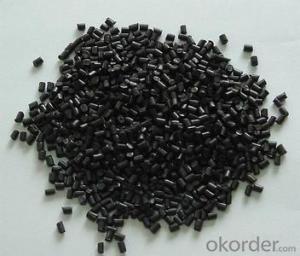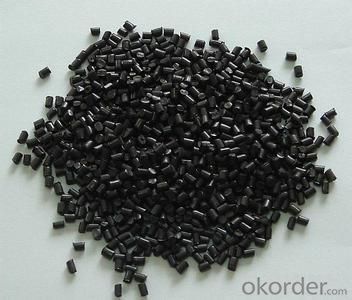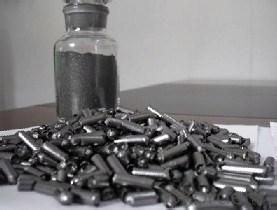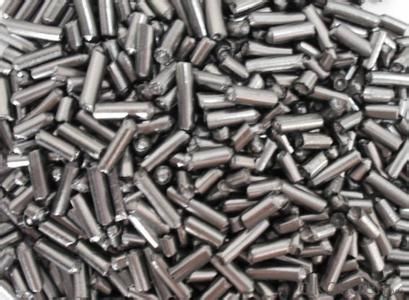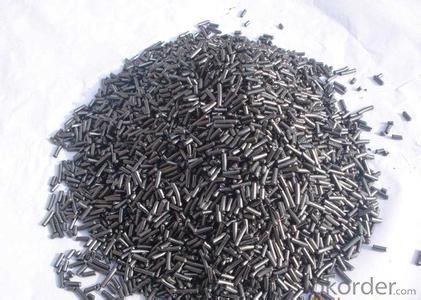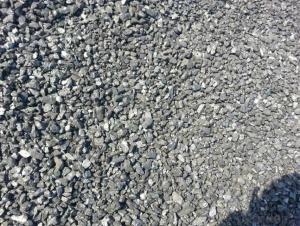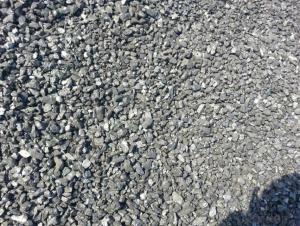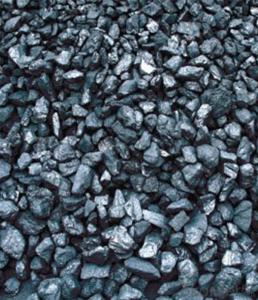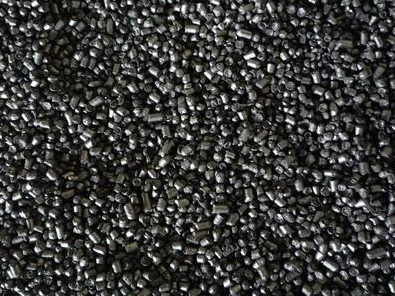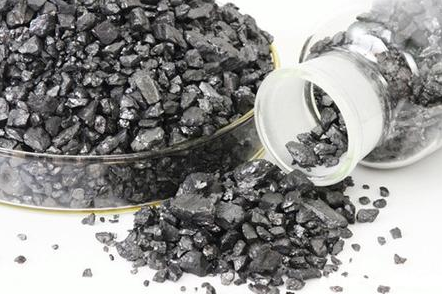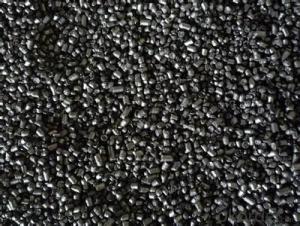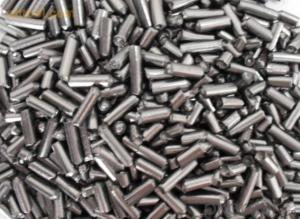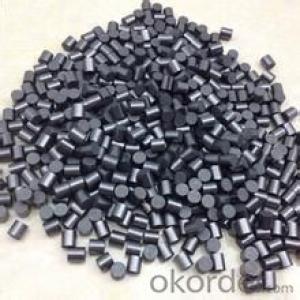carburant for casting iron and steel plant carbon additive and recarburizer
- Loading Port:
- Qingdao
- Payment Terms:
- TT OR LC
- Min Order Qty:
- 10 m.t
- Supply Capability:
- 300000 m.t/month
OKorder Service Pledge
OKorder Financial Service
You Might Also Like
Specifications of carburant:
- Carburant for casting professional manufacturer in china 15 years experience;
- Carburant for casting specification as follows:
Item No (max) | Fixed Carbon | Sulfur(max) | Ash(max) | V.M | Moisture | Grain size(90%) | Nitrogen(max) |
CA-02 | 98.50% | 0.50% | 0.80% | 0.80% | 0.50% | 1-5MM | N/A |
CA-06 | 99.00% | 0.30% | 0.50% | 0.50% | 0.50% | 1-5MM | 1000divdivM |
CA-10 | 95.00% | 0.30% | 3.50% | 1.50% | 0.50% | 1-4MM | 700divdivM |
CA-12 | 80.00% | 0.10% | 16.50% | 3.50% | 2.00% | 1-5mm | N/A |
By using the carbon additive from CNBM in producing casting, it can increase the used quantity of Scrap steel and reduce the quantity of Scrap iron, or use no Scrap iron at all, CNBM carbon additive has follows properties: high absorptive character, no residue will be left, save production cost.
- Usage used to improve the Carbon content in steel-melting and Ductile iron foundry
- Characteristica high carbon, low sulfur, with stable effect for improving the carbon content, high absorptivity of carbon.
- Apply Used in electric furnace steel smelting and cast-iron for improving the carbon content
- Grain size normal size0.3-3mm 1-4mm1-3mm3-5mm,3-8mm,5-10mm or per as customers special requirement.
- Q: What is carbon offsetting in aviation?
- Carbon offsetting in aviation is a mechanism that aims to neutralize the carbon emissions produced by the aviation industry. As airplanes are a significant source of greenhouse gas emissions, carbon offsetting provides a way for airlines and passengers to take responsibility for their carbon footprint and contribute to the fight against climate change. The process of carbon offsetting involves calculating the amount of carbon dioxide and other greenhouse gases emitted during a flight and then investing in projects that reduce an equivalent amount of emissions elsewhere. These projects can include renewable energy initiatives, forest conservation, or methane capture projects. The idea is that the emissions reduced or removed by these projects offset the emissions produced by the aviation industry. To participate in carbon offsetting, airlines or passengers can purchase carbon offsets, which are essentially credits representing the reduction or removal of one metric ton of carbon dioxide or its equivalent. These offsets are generated by certified projects that meet strict standards and are independently verified. By investing in carbon offsets, the aviation industry can contribute to global efforts to reduce greenhouse gas emissions and mitigate the impact of air travel on climate change. It allows airlines and passengers to take immediate action to counteract the environmental consequences of flying, as the reduction or removal of emissions from offset projects helps to balance out the emissions produced by air travel. Carbon offsetting in aviation is not a means to justify or ignore the need for long-term solutions to reduce emissions from aircraft. It should be seen as a complementary measure to other strategies such as investing in more fuel-efficient aircraft, using sustainable aviation fuels, and implementing operational improvements. However, carbon offsetting does provide a valuable tool to mitigate emissions in the short term while the aviation industry works towards more sustainable practices.
- Q: How are carbon nanomaterials used in electronics?
- Carbon nanomaterials are widely used in electronics due to their unique properties and versatility. One of the most common applications of carbon nanomaterials in electronics is in the development of highly efficient and flexible conductive materials. Carbon nanotubes (CNTs) and graphene, both carbon nanomaterials, possess excellent electrical conductivity, making them ideal for creating conductive components in electronic devices. CNTs are cylindrical structures made of rolled-up graphene sheets. They can be used as interconnects in integrated circuits, improving their performance by reducing resistance and enhancing heat dissipation. Additionally, CNTs can be used in transistors, enabling faster and more efficient switching due to their high electron mobility. Their small size and flexibility make them suitable for creating transparent conductive films used in touchscreens and flexible electronics. Graphene, on the other hand, is a two-dimensional sheet of carbon atoms arranged in a hexagonal lattice. It is renowned for its exceptional electrical conductivity, high electron mobility, and excellent thermal conductivity. Graphene-based materials can be used as electrodes in batteries and supercapacitors, enhancing their energy storage capacity. Graphene transistors have the potential to replace traditional silicon-based transistors, allowing for faster and more energy-efficient electronic devices. Moreover, carbon nanomaterials, particularly CNTs, have shown promise in the field of nanoelectromechanical systems (NEMS). NEMS devices are incredibly small and sensitive, enabling applications such as sensors, actuators, and resonators. CNT-based NEMS devices have demonstrated exceptional sensitivity and responsiveness, making them suitable for various sensing applications, including pressure, gas, and biological sensing. In summary, carbon nanomaterials play a crucial role in electronics by providing highly conductive and versatile materials for various components and applications. Their unique properties, such as excellent electrical and thermal conductivity, make them ideal for creating faster, more efficient, and flexible electronic devices. As research and development in this field continue to progress, carbon nanomaterials are expected to revolutionize the electronics industry.
- Q: What is diamond?
- Valued highly for its exceptional hardness, brilliance, and rarity, diamond is a precious gemstone. It is a form of carbon that has undergone intense heat and pressure deep within the Earth's mantle, resulting in its unique crystal structure. Diamond is known for its dazzling sparkle and is transparent and colorless, though it can also occur in various colors, such as yellow, blue, pink, and green, due to impurities during its formation. The brilliance of diamonds is maximized by cutting and polishing them into different shapes, making them popular in jewelry. Moreover, their remarkable durability allows them to be extensively used in industrial applications, including cutting, grinding, and drilling, due to their strength. Ultimately, the extraordinary beauty, durability, and scarcity of diamond have made it one of the world's most sought-after gemstones.
- Q: How does carbon affect the formation of smog?
- Carbon plays a significant role in the formation of smog, particularly in the form of carbon monoxide (CO) and volatile organic compounds (VOCs). When fossil fuels are burned, such as in vehicles, power plants, or industrial processes, carbon is released into the atmosphere in the form of CO and VOCs. These carbon emissions, especially in areas with high population density, can contribute to the formation of smog. Smog is a mixture of air pollutants, primarily ground-level ozone, which is formed when nitrogen oxides (NOx) and VOCs react in the presence of sunlight. Carbon monoxide is a precursor to the formation of ground-level ozone. It reacts with nitrogen oxides and sunlight to form ozone, a major component of smog. VOCs, on the other hand, react with nitrogen oxides in the presence of sunlight to form additional ground-level ozone. Additionally, carbon particles, also known as black carbon or soot, can contribute to the formation of smog. These particles absorb sunlight and heat the surrounding air, leading to temperature inversions. Temperature inversions trap pollutants close to the ground, preventing them from dispersing and exacerbating smog formation. Reducing carbon emissions is crucial in controlling and preventing smog formation. Implementing cleaner technologies, such as catalytic converters in vehicles and using cleaner fuels, can help decrease the release of carbon monoxide and VOCs. Furthermore, promoting renewable energy sources and reducing reliance on fossil fuels can significantly reduce carbon emissions, thus mitigating the formation of smog.
- Q: What are carbon-based superconductors?
- Carbon-based superconductors are a type of material that exhibit superconductivity, a phenomenon where electrical resistance drops to zero at low temperatures. Unlike conventional superconductors, which are typically metallic elements or alloys, carbon-based superconductors are composed primarily of carbon atoms. These materials are known for their unique structure and properties, which make them highly efficient conductors of electricity when cooled below a certain critical temperature. Carbon-based superconductors can be categorized into two main types: organic superconductors and fullerene superconductors. Organic superconductors are made up of carbon-based molecules, such as organic salts or polymers, which form a crystal lattice structure. These materials have been extensively studied and have shown promising superconducting properties at low temperatures. Fullerene superconductors, on the other hand, are composed of carbon molecules arranged in a specific cage-like structure, called fullerenes. The most well-known fullerene is C60, also known as a buckyball, which consists of 60 carbon atoms arranged in a soccer ball-like shape. By doping these fullerene cages with certain elements, such as alkali metals or transition metals, their superconducting properties can be enhanced. What makes carbon-based superconductors particularly interesting is their potential for high-temperature superconductivity. While most conventional superconductors require extremely low temperatures close to absolute zero (-273.15°C or -459.67°F) to exhibit superconductivity, some carbon-based superconductors have been found to retain their superconducting properties at relatively higher temperatures. This property is crucial for practical applications, as it allows for easier cooling and opens up possibilities for widespread use of superconductivity in various fields, including energy transmission, magnetic levitation, and quantum computing. However, it is important to note that carbon-based superconductors are still an active area of research, and many challenges remain in understanding their mechanisms and improving their superconducting properties. Nonetheless, the discovery and exploration of these materials hold great promise for advancing the field of superconductivity and enabling new technological breakthroughs.
- Q: What are the impacts of carbon emissions on the stability of mountain glaciers?
- Mountain glaciers are significantly affected by carbon emissions, which have significant consequences for their stability. The release of carbon dioxide and other greenhouse gases into the atmosphere contributes to global warming and climate change. This rise in global temperatures directly impacts the health and stability of mountain glaciers. One of the main outcomes of increased carbon emissions is the accelerated melting of mountain glaciers. Warmer temperatures cause glaciers to melt at a faster pace, resulting in a decrease in their size and volume. This not only affects the visual appeal of these natural wonders but also has major implications for water resources and ecosystems. Mountain glaciers serve as natural reservoirs, holding water in the form of ice and gradually releasing it over time. This process helps regulate water flow in rivers and streams, ensuring a consistent water supply for downstream communities, agriculture, and ecosystems. However, as carbon emissions contribute to glacier melting, this natural water storage mechanism is disrupted. The loss of glaciers leads to reduced water availability during dry seasons and can result in water scarcity for communities dependent on glacier meltwater. Moreover, the retreat of mountain glaciers due to carbon emissions has ecological consequences. These glaciers provide critical habitats for various plant and animal species. The loss of glacier ice and associated ecosystems can have a ripple effect on the entire ecosystem, resulting in the decline or even extinction of species reliant on glacier-fed environments. The impacts of carbon emissions on mountain glaciers also extend beyond local communities and ecosystems. Glacial meltwater plays a significant role in the overall water supply in many regions globally. As glaciers shrink and vanish, the availability of water resources becomes uncertain, particularly in areas heavily reliant on glacier meltwater. This can potentially lead to conflicts over water resources and worsen existing tensions. In conclusion, the stability of mountain glaciers is severely affected by carbon emissions. The accelerated melting of glaciers disrupts water availability, threatens ecosystems, and presents challenges for water resource management. It is crucial to reduce carbon emissions to mitigate these impacts and preserve the integrity and functionality of mountain glaciers.
- Q: What is the relationship between carbon emissions and air pollution?
- The close connection between carbon emissions and air pollution cannot be understated. Burning fossil fuels, such as coal, oil, and natural gas, is the main source of carbon emissions, which release substantial amounts of carbon dioxide (CO2) into the atmosphere. This surge in CO2 levels significantly contributes to the greenhouse effect, which traps heat in the atmosphere and leads to global warming. On the other hand, air pollution refers to the presence of harmful substances in the air that can be detrimental to both human health and the environment. Although carbon dioxide itself is not directly toxic to humans, it plays a critical role in the formation of other air pollutants. One of the primary consequences of increased carbon emissions is the creation of fine particulate matter (PM2.5) and ground-level ozone (O3). These pollutants are formed through intricate chemical reactions involving CO2 and other pollutants like nitrogen oxides (NOx) and volatile organic compounds (VOCs). PM2.5 and O3 are notorious for causing respiratory problems, cardiovascular diseases, and various other health issues. Moreover, carbon emissions also contribute to the development of other air pollutants, such as sulfur dioxide (SO2), nitrogen oxides (NOx), and heavy metals. These pollutants are emitted alongside CO2 during diverse industrial processes, power generation, and transportation. They can have severe health consequences, including respiratory diseases, asthma, and even cancer. The reduction of carbon emissions plays a pivotal role in combatting air pollution. By transitioning to cleaner energy sources, such as renewables, and enhancing energy efficiency, we can significantly decrease the amount of CO2 and other pollutants released into the atmosphere. The implementation of stricter regulations and the adoption of cleaner technologies in industries and transportation can also aid in the reduction of air pollution and its associated health risks. In conclusion, the connection between carbon emissions and air pollution is inseparable. The release of CO2 and other pollutants from burning fossil fuels contributes to global warming and the formation of harmful air pollutants. Addressing the issue of carbon emissions is imperative in mitigating air pollution and safeguarding human health and the environment.
- Q: How does carbon dioxide affect the formation of smog?
- Smog formation is not directly caused by carbon dioxide (CO2). Instead, it is primarily a result of sunlight interacting with other pollutants like nitrogen oxides (NOx) and volatile organic compounds (VOCs). These pollutants are emitted from various sources such as vehicles, industrial processes, and power plants. However, even though carbon dioxide doesn't directly participate in smog formation, it does have a significant impact on climate change. CO2 is a greenhouse gas, which means it traps heat in the Earth's atmosphere and contributes to global warming. As the planet warms, weather patterns can change, leading to more stagnant air conditions that worsen smog formation. Furthermore, the burning of fossil fuels, which releases carbon dioxide, is a major source of air pollutants like NOx and VOCs. So while CO2 itself may not directly cause smog, the activities that release CO2 indirectly contribute to smog formation by releasing other pollutants involved in its creation. Therefore, the influence of carbon dioxide on smog formation is indirect, primarily through its contribution to climate change and the release of other pollutants. By reducing carbon dioxide emissions and transitioning to cleaner energy sources, we can help mitigate climate change and indirectly decrease the factors contributing to smog formation.
- Q: What is carbon black rubber?
- Carbon black rubber is a type of rubber that contains carbon black as an additive. Carbon black is a finely divided form of carbon, produced by the incomplete combustion of hydrocarbon fuels. It is added to rubber compounds to improve its mechanical properties, such as tensile strength, abrasion resistance, and resilience. The carbon black particles are dispersed within the rubber matrix, providing reinforcement and enhancing its durability and performance. Carbon black rubber is commonly used in the production of tires, conveyor belts, gaskets, seals, and various automotive and industrial rubber products.
- Q: What is the importance of carbon dating in archaeology?
- Archaeology heavily relies on carbon dating, which plays a pivotal role in determining the age of artifacts and archaeological sites. This scientific technique is essential for establishing a chronological framework and comprehending the timeline of human history. Carbon dating operates on the principle that all living organisms contain a specific amount of radioactive carbon-14, which undergoes predictable decay over time. By quantifying the remaining carbon-14 in an artifact or organic material, archaeologists can calculate its age. This method is particularly advantageous when dating organic remains like bones, charcoal, and plant fibers, which are frequently unearthed at archaeological sites. The significance of carbon dating lies in its ability to deliver precise and trustworthy estimations of an artifact's age. This information is critical for interpreting and comprehending the context and importance of archaeological discoveries. By assigning an accurate date to an object or site, archaeologists can establish connections between different artifacts, societies, and cultures. This, in turn, aids in reconstructing ancient civilizations and their evolution throughout time. Moreover, carbon dating also contributes to refining and validating historical timelines. It enables archaeologists to cross-reference and authenticate the dating of artifacts and sites by employing alternative dating methods, such as dendrochronology (tree-ring dating) or stratigraphy (the study of rock layers). Employing multiple dating techniques enhances the accuracy and reliability of archaeological interpretations. Carbon dating also assists in identifying and distinguishing genuine artifacts from forgeries. By analyzing the age of an object, archaeologists can determine if it aligns with the claimed historical context. This is especially pertinent in the realm of art and antiquities, where the market for counterfeits can be lucrative. In conclusion, carbon dating is an indispensable tool in archaeology, enabling researchers to establish the chronology of ancient civilizations, validate historical timelines, and identify authentic artifacts. It provides invaluable insights into our past, facilitating a deeper understanding and appreciation of the diverse tapestry of human history.
Send your message to us
carburant for casting iron and steel plant carbon additive and recarburizer
- Loading Port:
- Qingdao
- Payment Terms:
- TT OR LC
- Min Order Qty:
- 10 m.t
- Supply Capability:
- 300000 m.t/month
OKorder Service Pledge
OKorder Financial Service
Similar products
Hot products
Hot Searches
